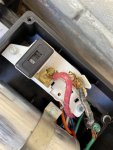So when I was testing at pump with voltmeter, should both red-to-ground and black-to-ground shown same voltage? Assuming 230V, given the wire colors
Note: Do not switch to 115 volts unless you are sure that the supply is really 115 or you will definitely burn up the motor.
I'm pretty sure that the original power was 230 volts because the wires are black and red.
If the original supply was 115 volts, the wires should be black and white.
I suspect that the power supply is damaged somewhere.
Was the old motor set to 115 or 230 volts?



